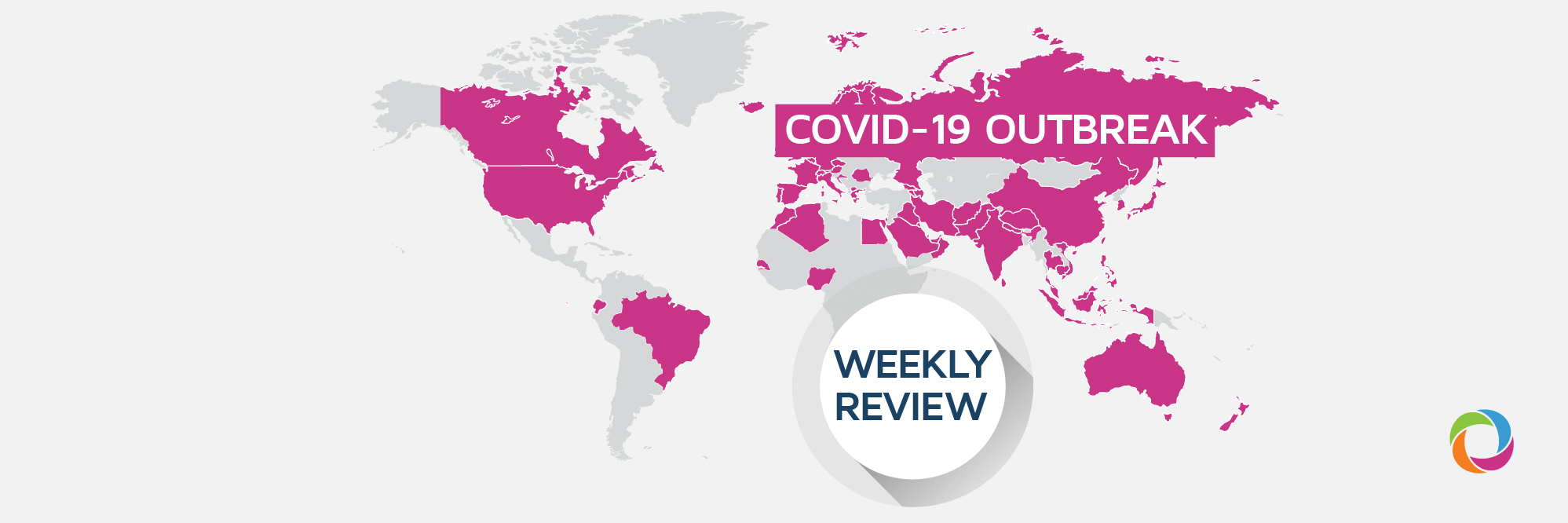(February 25 – March 3, 2020)
Almost 11,000 new COVID-19 positive patients have been recorded worldwide since last Monday, February 24 and, in the same time frame, around 20,000 people have been cured. The total number of people affected by the coronavirus has reached a little over 90,500 since the outbreak of the disease in late December 2019. Over a half of the patients, 48,063 people, have totally recovered while 3,117 people have died according to a data portal of the Johns Hopkins University, as of March 3rd, 2020.
During the past week, the number of countries affected by the virus had doubled reaching 72 in total. Brazil, the Dominican Republic and Ecuador are the first three countries on the South American continent with registered cases of COVID-19. In Africa, the coronavirus has spread to Nigeria and Senegal during the past week. Thus, there are three countries on this continent already affected by COVID-19.
Italy is suffering the most out of all EU countries with 908 new cases registered within the last 48 hours. Overall, 2036 people have been diagnosed with COVID-19 in this country with 52 reported deaths, according to data from the World Health Organization (WHO).
Today, the risk of the spread and the risk of the impact of the COVID-19 coronavirus are ‘very high’ after the WHO increased its assessment on Friday, February 28th. Speaking to journalists in Geneva on March 2nd, the Director-General of WHO, Tedros Adhanom Ghebreyesus, noted that in the previous 24 hours the number of infections outside China was nine times greater than the number inside the country where the virus emerged in December 2019.
Efforts by the development community to tackle the outbreak
In its Strategic Preparedness and Response Plan, drafted at the beginning of February, the WHO called for US$675 million to support the most vulnerable countries against the COVID-19 outbreak. US$61.5 m of this amount is intended for WHO’s urgent preparedness and response activities for the period from February to April 2020. So far, the organization has received US$2.5 million. During the past week, the Czech Republic and Norway have contributed US$262,000 and US$1.1 m respectively. In total, four countries and one organization have so far contributed to the WHO’s response plan.
However, according to the WHO website, the list of contributors also includes the Bill and Melinda Gates Foundation, Canada, Czech Republic, the European Union, Japan, Norway and the United Kingdom. At the same time, Canada, Denmark, Germany, Netherlands, Sweden and Kuwait provided funding to WHO’s Contingency Fund for Emergencies (CFE). The CFE is a critical response mechanism to outbreaks around the world including the new coronavirus (COVID-19) outbreak.
On March 2nd, the Croatian presidency of the European Council decided to escalate the Integrated Political Crisis Response (IPCR) arrangements from information sharing mode to full activation mode. This mode allows for an increased focus on searching for major gaps across sectors and enlarging upon concrete EU response measures at presidency-led round tables where proposals for actions can be developed and discussed, as well as decided upon by the Council, according to the institution’s web-site.
On the other side of the Atlantic, USAID has announced an approximately US$37 million commitment in assistance to respond to COVID-19. These funds will be directed to the WHO and aim to help the governments of currently affected or at-risk of developing, countries to prepare their laboratories for large scale testing for COVID-19, implement a public health emergency plan for points of entry, activate case finding and event based surveillance for influenza-like illnesses, train and equip rapid response teams, investigate cases and trace the contacts of infected persons and adapt training materials for health workers on COVID-19.
Another US$15 million has been released by the United Nations. The funds will be channeled to increase global efforts to contain the COVID-19 virus, specifically with regard to financing essential activities including monitoring its spread, investigating cases and the operation of national laboratories, according to UN Humanitarian Chief Mark Lowcock.
All ongoing international tenders related to the COVID-19 can be found on developmentaid.org.
Stay tuned for the next DevelopmentAid Weekly Review of the coronavirus situation across the world to be released on March 10th. Subscribe to our newsletter and learn more about the coronavirus outbreak and the efforts of the international development community to tackle it.
About COVID-2019
Coronaviruses are a large family of viruses that are common in many different species of animals including camels, cattle, cats and bats. Rarely, animal coronaviruses can infect people and then spread between them such as was the case with MERS (2012) and SARS (2003).The symptoms of the virus are very similar to those of a common cold – runny nose, headache,cough,sore throat, fever, a general feeling of being unwell. Blood tests are necessary in order to prove the presence of the virus in the organism.
Named by scientists as the “Wuhan seafood market pneumonia virus”, 2019-nCoV is a coronavirus, like MERS and SARs, all of which have their origins in bats. Initial reports show that, in the early stages of the outbreak (early January 2020), many of those infected in Wuhan had some link to a large seafood and live animal market – the Huanan Seafood Wholesale Market, mainly its western wing where wildlife animals are traded. This suggests that the virus initially affected an animal and subsequently spread to a person in a what a CDC has called “the species barrier jump”.

